
Charles Leclerc says the porpoising effect suffered by F1's new generation cars produced a sensation similar to turbulence in an airplane and made him feel "a little bit ill".
Porpoising, or a car's unstable vertical pumping movement caused by aero forces circulating within a car's underbody, was a well-known by-product of Formula 1's ground-effects era in the late seventies and early eighties.
But the phenomenon came back to haunt teams in pre-season testing in Barcelona with each outfit now devising solutions to mitigate the effect that makes a driver's ride very uncomfortable at high speed on the straights.
"It feels like turbulence on an aeroplane, going up and down the whole straight," said Leclerc.
"I think one of the videos that F1 posted shows this phenomenon quite well, and I can't say it feels nice. It makes you a little bit ill, but it's okay.
"It's still very early days for this project. So it feels like it's an issue that everyone has in the paddock more or less but yeah, in this paddock all the best engineers of the world are here so I'm pretty sure that we'll find a solution."
Bumpy road to the top for Charles Leclerc! 🤕#F1 pic.twitter.com/Z6a5e6d3bo
— Formula 1 (@F1) February 24, 2022
While solutions exist to minimize a car's porpoising effect, like increasing its ride height, teams will need to apply a fix that does not compromise a design's performance.
Former F1 and Ferrari aerodynamicist Jean-Claude Migeot believes engineers are constrained to find a mechanical solution to the problem and will need to look for a fix on the aero side of things. But Migeot warns that this could take time
"The remedies on the mechanical side, knowing that active suspension is forbidden the number of things that are not there, you are left with very little freedom or parameters to play with," Migeot told Motorsport.com.
"You cannot ignore the optimisation of the static forces that put the car in the best position for whatever corner you choose. That is strategic.
"On the suspension side, unless you're making some invention - like at the time of the skirts, an inerter could be there and maybe that can help, but it's forbidden again.
"So that solution is in the windtunnel. The solution is looking at these forces and optimising them together with static forces.
"I'm afraid this will take time, because we've just seen the tip of the iceberg in Barcelona."
Migeot also went as far as to suggest that if porpoising isn't brought quickly under control, drivers could be facing "tragic" consequences on bumpy tracks.
"It's going to be tragic on a bumpy track, and it's going to be tragic in racing, because when you're hard braking for overtaking you're going to excite this phenomenon a lot," he said.
"So we're maybe going to see very bad things. I think the FIA will react before that. If nobody has time to find the best solution, the FIA will have to react.
"I hope to be wrong, of course, because it will be a nasty surprise.
"They have relied a lot on the downforce from the underbody, they get rid of the step almost completely.
"That may have been the reason of all that. But if they add that back, the downforce is going to fall so we're going to have to face very slow cars, which is not good, but maybe less worse for the moment."
Keep up to date with all the F1 news via Facebook and Twitter







